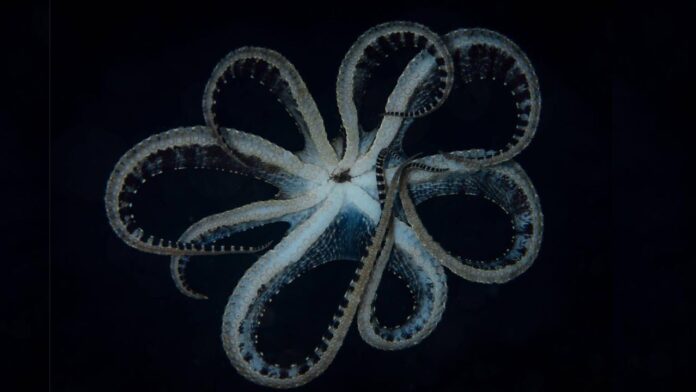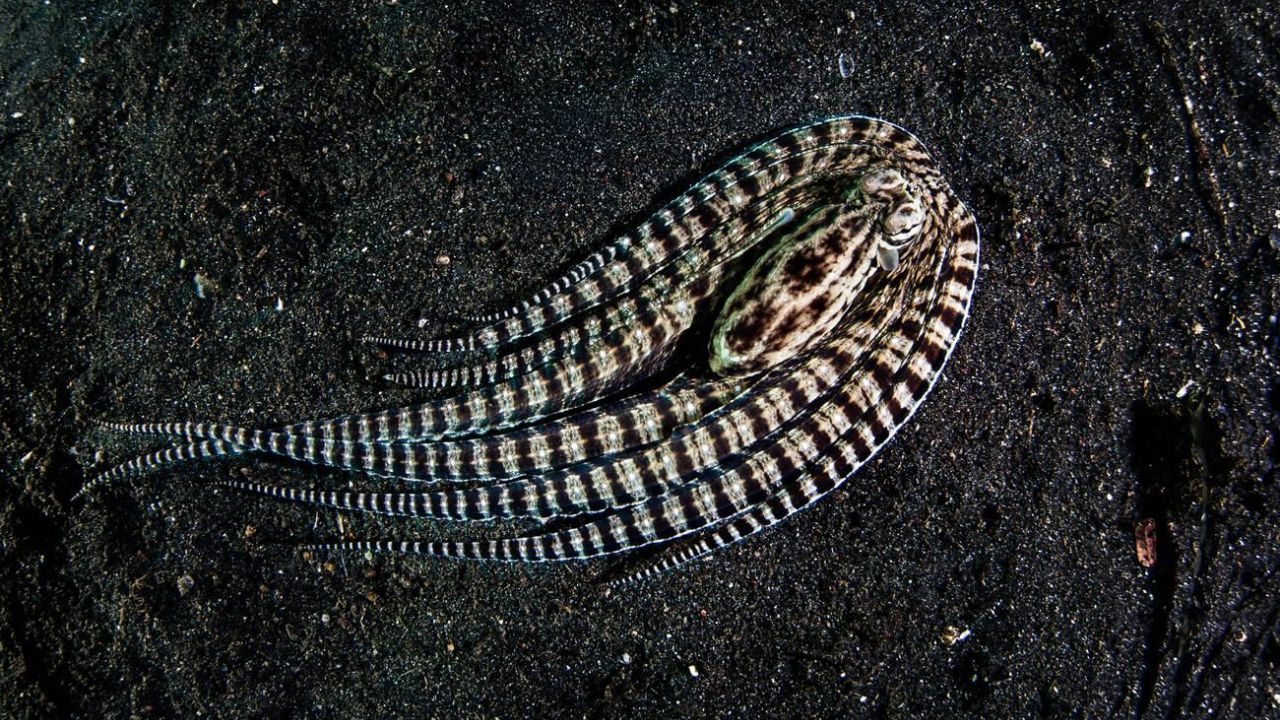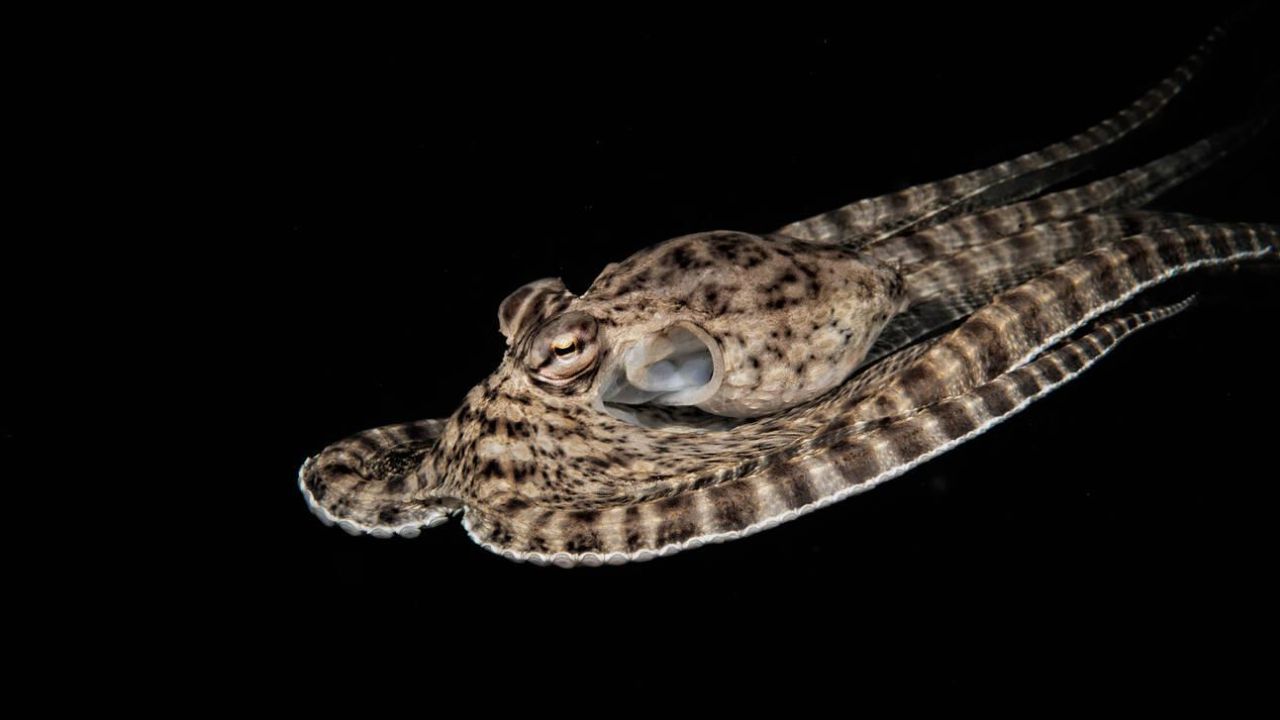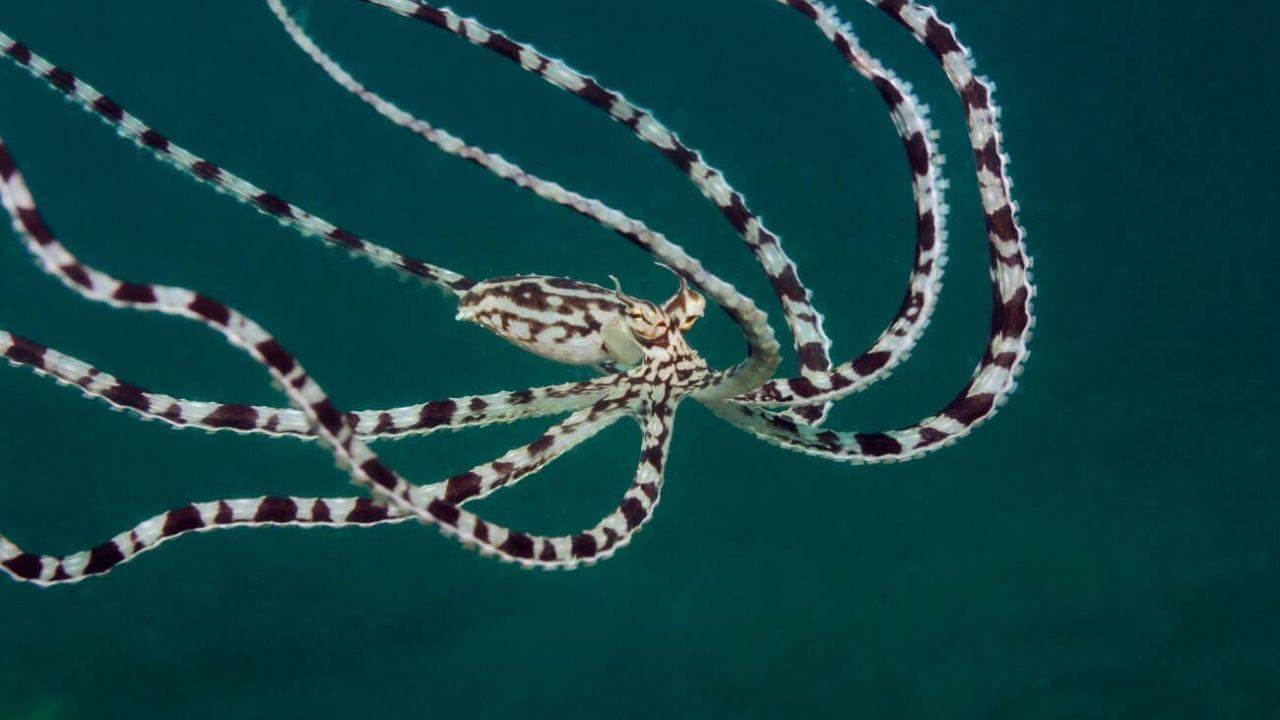The depths of the ocean hold many wondrous creatures, but few as astonishing as the mimic octopus. With its uncanny ability to impersonate a wide range of marine animals, this incredible cephalopod has captured the fascination of scientists and aquarium visitors alike.
The mimic octopus (Thaumoctopus mimicus) is a little-known inhabitant of the tropical seas of Southeast Asia. First discovered in 1998 off the coast of Sulawesi, Indonesia, it immediately became apparent that this small octopus had talents unlike any other. By manipulating its soft body and using color-changing chromatophores in its skin, the clever mimic octopus can transform its appearance in the blink of an eye to impersonate an astounding repertoire of creatures.
Content Highlights
- With no internal skeleton, the mimic octopus can transform its soft body into a remarkable variety of animal shapes for camouflage.
- Through colorful skin cells called chromatophores, the mimic octopus can instantly match the patterns of the species it is impersonating.
- By mimicking dangerous marine animals like lionfish and sea snakes, the defenseless mimic octopus scares away potential predators from attacking it.
- Researchers have documented over 20 distinct animal mimics used by the clever mimic octopus for self-defense.
- The mimic octopus likely learns effective mimicry through observation and practice rather than pure instinct.
- With as few as a couple hundred existing globally, the rare mimic octopus urgently requires expanded legal protections.
- Video footage clearly reveals the spellbinding talents that make the mimic octopus a genius of illusion worthy of conservation.
The phenomenal mimic octopus displays cognitive abilities unmatched in the animal world, along with a chameleonic mastery of disguise. While its very existence now hangs precariously in the balance, one can only hope that humanity will wake up to the tragedy of losing one of evolution’s most gifted impersonators. We still have so much left to uncover about this unassuming but mighty master of deception patrolling the sandy expanses of the tropical seas.
An Expert Impersonator
So what exactly enables the extraordinary impersonation abilities of the mimic octopus? The secret lies in its flexible body, ability to change color and skin texture, and clever behaviors that allow it to mimic the movements of other animals.
Read More: Help Endangered Species
With no internal or external skeleton, the mimic octopus can contort its soft body into a variety of shapes. By pulling its arms together, it can assume the shape of a flatfish or sole. Stiffening two arms, it can resemble a sea snake or lionfish. Even more incredibly, it can impersonate creatures like stingrays and jellyfish that look nothing like an octopus.
The mimic octopus further sells its impersonations using color-changing cells known as chromatophores. In a split second, it can produce stripes, dots, blotches, or other patterns to match the species it is mimicking. It can also change the texture of its skin to better blend in.
Finally, the mimic octopus has learned clever behaviors to act like the animals it impersonates. To mimic a venomous sole, it waves its arms back and forth as if walking along the seafloor. When impersonating a lionfish, it spreads its arms and moves with exaggerated undulations. This detailed mimicry makes its performances utterly convincing.
A Master of Disguise
The mimic octopus uses its uncanny impersonation skills for a single purpose: self-defense. By mimicking dangerous or toxic animals, it scares away potential predators that would otherwise see it as prey.
Some of the creatures most commonly mimicked by the mimic octopus include:
- Lionfish: Most predators stay away from the lionfish because of its striking stripes and spiky fin rays. By shaping itself like a lionfish and moving in a slow, undulating fashion, the mimic octopus successfully dupes other animals into thinking it too is dangerous.
- Sole and Flounder: These flatfish species blend perfectly into the seafloor with their mottled sand-colored bodies. By pulling its arms together and taking on the characteristic flat shape of a sole or flounder, the mimic octopus can disappear against similar backgrounds.
- Sea Snake: Highly venomous sea snakes patrol the tropical waters where mimic octopuses live. By arranging two arms parallel together, the mimic octopus can closely resemble a sea snake to scare off enemies.
- Jellyfish: With their stinging tentacles, jellyfish are untouchable to most marine creatures. The mimic octopus can shape part of its body into a jellyfish-like dome while trailing its arms to mimic harmless tentacles.
This list is just a small sampling of the animals impersonated by the clever mimic octopus. Researchers have observed over 20 distinct mimics, and the full range of performance abilities for this amazing creature is still being uncovered.
The Genius of Mimicry
The mimic octopus displays uncanny intelligence in knowing what creatures to impersonate that will scare off specific predators. For example, it may mimic a sole when threatened by a bottom-dwelling predator like a stingray but will transform into a lionfish to deter open-water hunters.
Research has revealed fascinating insights into how this genius of mimicry works. According to one study, mimic octopuses appear to observe other animals in their environments and then select a mimic that the threatening predator typically avoids. It also seems that mimicry performance is a learned rather than purely instinctual behavior, with observation and practice required to perfect the impersonations that work best for survival.
Additionally, the mimic octopus shows advanced cognitive flexibility by being able to switch seamlessly between multiple mimics. If one performance doesn’t chase off an attacker, it rapidly shifts to another, cycling through its repertoire until finding the disguise that induces retreat. This hints at problem-solving intelligence and creativity rarely documented in invertebrates.
Read Also: 5 Most Important Vaccinations for Your Dogs
So while its brain is only the size of a pea, the curious mimic octopus displays all the hallmarks of a mental heavyweight in the animal kingdom. Through the innovative use of flexible camouflage, it has found evolutionary success by tricking enemies rather than using venom, strength or speed.
A Rare and Elusive Artist
Sadly, the existence of the phenomenal mimic octopus hangs in a precarious balance. As only a handful of sightings have occurred in the wild, current estimates suggest as few as a couple hundred mimic octopuses across their entire habitat range.
Several factors contribute to their rarity. They inhabit relatively shallow tropical waters, environments critically threatened by destructive fishing practices and coastal development. With such a tiny population size, they remain at high risk of extinction from human activities or natural disasters.
Compounding these threats is their reclusive nature. Mimic octopuses spend most of their time hiding in holes on muddy or sandy bottoms, with only occasional forays into open water to hunt small prey like shrimp and crabs. Their elusive habits make them a challenge for researchers to study and conserve.
Nonetheless, the prospect of losing the mimic octopus and its wonderful talents is a disturbing one. Increased legal protections, designation as an endangered species, and establishment of marine protected areas may help rescue this rare animal from its slippery slope toward oblivion.
The mimic octopus is truly one of Earth’s most skilled masters of illusion and deception. To lose its kind would be to lose a unique example of the ocean’s endless capacity for unleashing marvels that surpass our imagination.
Key Facts about the Mimic Octopus
| Taxonomy | Thaumoctopus mimicus |
|---|---|
| Habitat | Tropical coral reefs, muddy or sandy bottoms at 15-200 ft depths |
| Range | Southeast Asia (Indonesia, Malaysia, and the Philippines) |
| Size | It grows up to 2 feet long. |
| Life Span | Unknown, likely just a few years |
| Mimics | At least 20 different species, including sole, lionfish, sea snakes, and jellyfish |
| Diet | Shrimp, crabs, and other small crustaceans |
| Defenses | Camouflage or mimicry instead of venom or ink |
| Population | Few hundred estimated globally |
| Conservation Status | Not currently protected or listed as threatened |
Frequently Asked Questions About the Mimic Octopus
What species does the mimic octopus impersonate?
The mimic octopus has been observed impersonating over 20 different marine species through camouflage and adaptations in behavior. Some of the most frequent mimics are lionfish, sole, flounder, sea snakes, and jellyfish.
Why does the mimic octopus mimic other sea creatures?
Mimicry serves as a self-defense mechanism for the mimic octopus. By disguising itself as a dangerous or toxic species like lionfish and sea snakes, it deters potential predators that would otherwise see it as prey.
How does the mimic octopus change how it looks?
Through specialized color-changing cells called chromatophores, the mimic octopus can rapidly alter its skin appearance to match the species it is impersonating. It can produce stripes, spots, textures, and patterns instantaneously.
Where does the mimic octopus live?
The mimic octopus is only found in tropical coral reef environments in Southeast Asia, especially Indonesia, Malaysia, and the Philippines, in depths ranging from 15 to 200 feet.
Why is the mimic octopus population so small?
As a newly discovered species in the late 1990s, mimic octopuses have always had small population sizes. The degradation of its coral reef habitat combined with its naturally reclusive habits causes it to remain extremely rare, numbering likely a few hundred worldwide.
Is the mimic octopus endangered?
No, the mimic octopus is not currently listed as endangered or protected, despite risks from habitat loss and its tiny population. Obtaining legal safeguards for the species is an important goal for conservation efforts going forward.


















![Technical Aspects of 844 Area Code in 2024 [Detail Guide] 844 Area Code](https://articleify.com/wp-content/uploads/2024/01/844-Area-Code-150x150.jpg)














